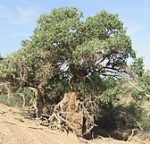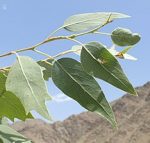 Also known as desert poplar, firat poplar, and salt poplar, this deciduous tree is native to North Africa, the Middle East, Central Asia and western China where it grows in woodlands, shrublands and deserts as well as in the floodplains of arid and semi-arid areas. It is a member of the willow family, Salicaceae, that also includes aspen and cottonwood. The trees grow 30-45′ tall, and have a wide but relatively shallow root system. The stem is usually bent or forked and develops a thick, rough, olive green bark with maturity. White sapwood surrounds red heartwood that is almost black in the center. The leaves on young trees and the sterile lower branches of older plant are linear to lanceolate with entire margins while those on fertile branches are elliptic, oblong, ovate, rhomboid or deltoid and often irregularly dentatate. The leaf blades are stiff textured and carried on weak flattened petioles facilitating the creation of a rustling sound in a breeze. Male and female catkins of appear in late winter to early spring. The male catkins are about 1-2″ long while the female catkins are about 2-3″ long. The ovoid-lanceolate capsules are less than 1″ long and contain tiny seeds wraped in silky hairs. Euphrates poplar grows well in seasonally flooded land and is tolerant of saline and brackish water. The trees are useful for afforestation, erosion control, and as windbreaks. The wood has been used for firewood, the leaves for fodder, and the fiber for paper. The genus name, Populus, is the Latin word meaning people and may refer to the use of some members of the genus in public places. The specific epithet, euphratica, is the Latinized form of Euphrates, referring to the river where it is native.
Also known as desert poplar, firat poplar, and salt poplar, this deciduous tree is native to North Africa, the Middle East, Central Asia and western China where it grows in woodlands, shrublands and deserts as well as in the floodplains of arid and semi-arid areas. It is a member of the willow family, Salicaceae, that also includes aspen and cottonwood. The trees grow 30-45′ tall, and have a wide but relatively shallow root system. The stem is usually bent or forked and develops a thick, rough, olive green bark with maturity. White sapwood surrounds red heartwood that is almost black in the center. The leaves on young trees and the sterile lower branches of older plant are linear to lanceolate with entire margins while those on fertile branches are elliptic, oblong, ovate, rhomboid or deltoid and often irregularly dentatate. The leaf blades are stiff textured and carried on weak flattened petioles facilitating the creation of a rustling sound in a breeze. Male and female catkins of appear in late winter to early spring. The male catkins are about 1-2″ long while the female catkins are about 2-3″ long. The ovoid-lanceolate capsules are less than 1″ long and contain tiny seeds wraped in silky hairs. Euphrates poplar grows well in seasonally flooded land and is tolerant of saline and brackish water. The trees are useful for afforestation, erosion control, and as windbreaks. The wood has been used for firewood, the leaves for fodder, and the fiber for paper. The genus name, Populus, is the Latin word meaning people and may refer to the use of some members of the genus in public places. The specific epithet, euphratica, is the Latinized form of Euphrates, referring to the river where it is native.

Type: Deciduous tree
Outstanding Feature: Use as firewood, leaves for fodder
Form: Oval
Growth Rate: Rapid
Bloom: Catkins of male and female flowers in late winter to early spring
Size: 30-45′ H
Light: Full sun
Soil: Average, moist to wet, tolerates inundation
Hardiness: Zones 5-11
Care: Low maintenance
Pests and Diseases: City longhorn beetle, Alternaria leaf spot
Propagation: Seed
Photo Credits: Wikipedia, Wikipedia